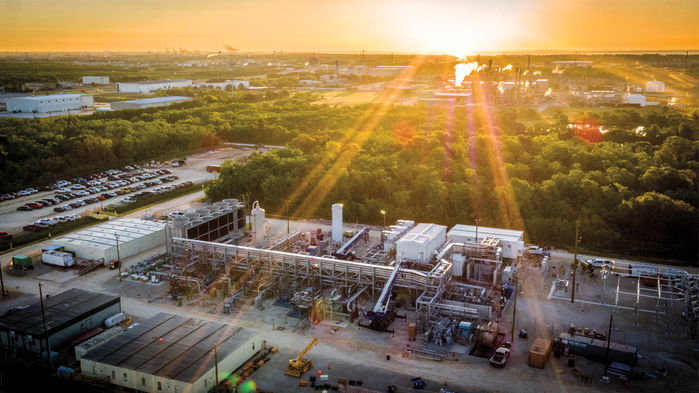(photo credit: CHICAGO BRIDGE & IRON)
This is NET Power’s prototype plant near Houston, Texas. It is testing an emission-free technology designed to compete with conventional fossil power.
Zero-emission fossil fuel power sounds like an oxymoron. But when that 25-megawatt demonstration plant is fired up later this year, it will burn natural gas in pure oxygen. The result: a stream of nearly pure CO2, which can be piped away and stored underground or blasted into depleted oil reservoirs to free more oil, a process called enhanced oil recovery (EOR). Either way, the CO2 will be sequestered from the atmosphere and the climate.
That has long been the hope for carbon capture and storage (CCS), a strategy that climate experts say will be necessary if the world is to make any headway in limiting climate change. But CCS systems bolted to conventional fossil fuel plants have struggled to take off because CO2 makes up only a small fraction of their exhaust. Capturing it saps up to 30% of a power plant’s energy and drives up the cost of electricity.
In contrast, NET Power, the startup backing the new plant, says it expects to produce emission-free power at about $0.06 per kilowatt-hour. That’s about the same cost as power from a state-of-the-art natural gas-fired plant—and cheaper than most renewable energy. The key to its efficiency is a new thermodynamic cycle that swaps CO2 for the steam that drives turbines in conventional plants. Invented by an unlikely trio—a retired British engineer and a pair of technology geeks who had tired of their day jobs—the scheme may soon get a bigger test. If the prototype lives up to hopes, NET Power says, it will forge ahead with a full-scale, 300-megawatt power plant—enough to power more than 200,000 homes—which could open in 2021 at a cost of about $300 million. Both the company and CCS experts hope that the technology will then proliferate. “This is a game-changer if they achieve 100% of their goals,” says John Thompson, a carbon capture expert at the Clean Air Task Force, an environmental nonprofit with an office in Carbondale, Illinois.
Even if NET Power’s technology works as advertised, not everyone will be a fan. Lukas Ross, who directs the climate and energy campaign at Friends of the Earth in Washington, D.C., notes that the natural gas that powers the plant comes from hydraulic fracturing, or “fracking,” and other potentially destructive practices. And providing a steady supply of high-pressure gas for EOR, he adds, will only perpetuate a reliance on fossil fuels. Ross argues that money would be better spent on encouraging broad deployment of renewable energy sources, such as solar and wind power.
Yet oddly enough, NET Power could help smooth the way for renewables to expand. The renewable portfolio standards in many countries and U.S. states require solar, wind, and other carbon-free sources to produce an increasing proportion of the electric power supply. But those sources are intermittent: The power comes only when the sun is shining and the wind is blowing. Nuclear and fossil fuel sources provide “base load” power that fills the gaps when renewables aren’t available. Conventional natural gas power plants, in particular, are viewed as a renewable-friendly technology because they can be ramped up and down quickly depending on the supply of renewable power.
CEF FFT: Although this is not an ideal solution, perhaps this is a step in the right direction. Who knows what this new Allam Cycle could inspire in other renewables.
Visit source article on Sciencemag.org for more information and diagrams!


Comments are closed